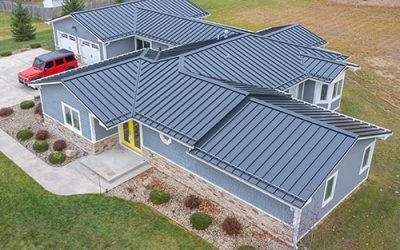Common Roofing Problems and Solutions in Indiana
Roofing is an essential aspect of homeownership. A high-quality and well-maintained roof doesn’t just protect your home and possessions from the elements, it also improves the quality of the indoor environment and helps create the right ambiance.
In Indiana, where the climate can be unpredictable and harsh at times, homeowners have to understand the common roofing issues so they can react promptly and prevent substantial financial consequences.
Let’s take a closer look at common roofing problems in Indiana and explore the available solutions.
Common Roofing Problems in Indiana
Indiana’s severe weather conditions can create a multitude of roofing issues. The most common are:
Ice and Snow Buildup
Ice dams and snow accumulation are two common winter problems that homeowners encounter. Prolonged cold temperatures can cause ice to build up along the edges of roofs, blocking melting snow from draining off. As a result, the water seeps underneath the shingles, leading to leaks and moisture damage inside the home.
To prevent this, Indiana homeowners can install heat cables along the roof’s edge, which help melt the ice and snow. Regular removal of snow from the roof can also prevent the formation of ice dams.
Shingles Damage
High winds and storms are another significant threat to Indiana homes. These conditions can strip shingles from the roof, leaving the underlayment exposed and susceptible to leaks.
Homeowners can mitigate wind damage by using high-quality roofing materials and proper installation techniques. After a storm, you have to inspect the roof for damage and make necessary repairs as soon as possible.
Mold and Mildew
Heat and humidity-related issues are prevalent during Indiana summers. The constant exposure to harsh sun rays and high humidity can result in curling or buckling of shingles, and excess moisture can cause mold and mildew growth.
Regular roof inspections are crucial for addressing these issues early. Ventilation systems can help reduce heat and humidity levels in the attic, protecting the roof from these problems.
If you don’t have experience and training to inspect the roof on your own, doing this can be dangerous. You need special equipment to ensure your safety at heights, especially in rough weather conditions.
Specific Roofing Materials for Indiana
The material used for roofing can significantly impact its performance and longevity. Some roofing materials to consider include:
Asphalt Shingles
Advantages:
- Cost-effective and widely available
- Easy to install and repair
- Good durability against wind and fire
Disadvantages:
- Vulnerable to temperature fluctuations and UV damage
- Shorter lifespan compared to other materials (typically 20-30 years)
Metal Roofing
Advantages:
- Excellent durability and longevity (can last 50+ years)
- Resistant to fire, wind, and extreme weather conditions
- Energy-efficient and environmentally friendly
Disadvantages:
- Higher initial cost compared to asphalt shingles
- Can be noisy during heavy rain or hail storms without proper insulation
Slate Roofing
Advantages:
- Exceptional durability and lifespan (100+ years)
- Highly resistant to fire, wind, and extreme weather
- Aesthetically pleasing and adds value to the property
Disadvantages:
- Expensive material and requires professional installation
- Heavyweight, which may require additional structural support
- Fragile and prone to breakage if walked on or impacted by debris
Synthetic Roofing Materials
Advantages:
- Wide range of options imitating natural materials (such as synthetic slate or cedar shakes)
- Lightweight and easy to install
- Good resistance to fire, wind, and extreme weather
Disadvantages:
- Quality and longevity can vary depending on the specific product
- Some synthetic materials may fade or deteriorate over time due to UV exposure
When choosing the best roofing material for Indiana’s climate, it is important to consider factors such as durability, cost, aesthetics, and maintenance requirements. Consulting with a professional roofer can help you make an informed decision.
Roofing Solutions and Maintenance Tips
In Indiana, taking proactive steps can help homeowners avoid significant roofing problems.
Regular inspections and maintenance routines are essential. These checks can help detect minor issues before they escalate into major problems. Homeowners should pay special attention to loose or damaged shingles, signs of moisture, and damaged flashing.
Professional roofing services in Indiana can provide expert advice and services. From routine inspections to repairs and replacements, these specialists can ensure the roofs are properly maintained and prepared to withstand Indiana’s harsh weather conditions.
Environmental Considerations for Roofing in Indiana
Environmentally friendly roofing options, such as green roofs and solar panel installations, are becoming popular in Indiana. These can reduce energy consumption and provide insulation.
A well-maintained roof significantly contributes to a home’s energy efficiency. It keeps the property warmer in winter and cooler in summer, reducing energy costs.
Keeping Your Indiana Roof in Top Shape
A well-maintained roof is not only a shield against the elements but a contributing factor to a home’s energy efficiency and a key to sustainable living. Understanding the common roofing problems in our state helps homeowners to take proactive steps to prevent them.
By choosing suitable roofing materials, performing regular maintenance, and hiring professional services when needed, Indiana homeowners can protect their homes and save on repair costs. The earlier you start taking care of your roof, the more likely it is to avoid damage and serve you for many years.
A well-maintained roof is not only a shield against the elements but a contributing factor to a home’s energy efficiency and a key to sustainable living. Understanding the common roofing problems in our state helps homeowners to take proactive steps to prevent them.
By choosing suitable roofing materials, performing regular maintenance, and hiring professional services when needed, Indiana homeowners can protect their homes and save on repair costs. The earlier you start taking care of your roof, the more likely it is to avoid damage and serve you for many years. Learn more about the importance of professional roofing services by consulting with a roofing contractor in Indiana.









